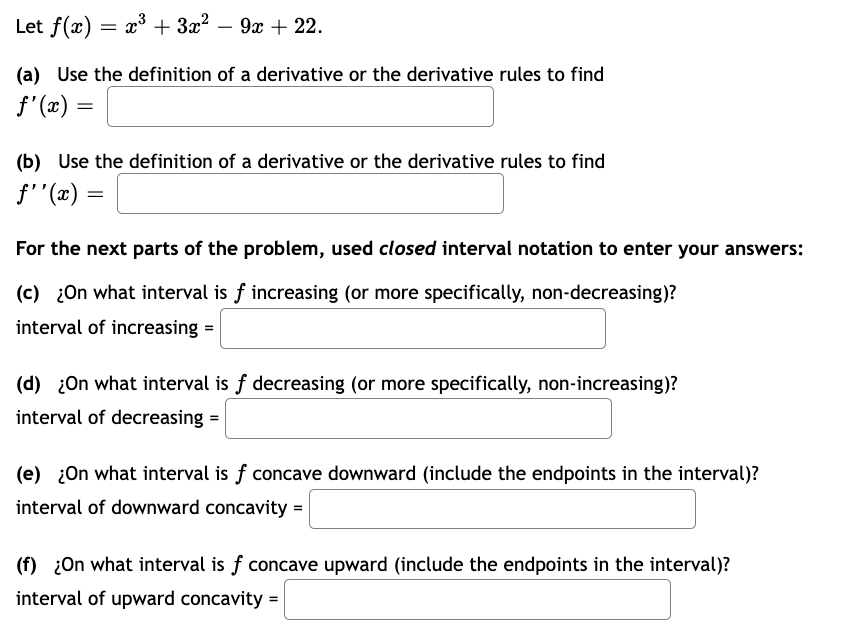Let ƒ(x) = x³ + 3x² − 9x + 22. (a) Use the definition of a derivative or the derivative rules to find ƒ'(x) = (b) Use the definition of a derivative or the derivative rules to find ƒ''(x) = For the next parts of the problem, used closed interval notation to enter your answers: (c) ¿On what interval is f increasing (or more specifically, non-decreasing)? interval of increasing = (d) ¿On what interval is f decreasing (or more specifically, non-increasing)? interval of decreasing = (e) ¿On what interval is f concave downward (include the endpoints in the interval)? interval of downward concavity = (f) ¿On what interval is f concave upward (include the endpoints in the interval)? interval of upward concavity =
Let ƒ(x) = x³ + 3x² − 9x + 22. (a) Use the definition of a derivative or the derivative rules to find ƒ'(x) = (b) Use the definition of a derivative or the derivative rules to find ƒ''(x) = For the next parts of the problem, used closed interval notation to enter your answers: (c) ¿On what interval is f increasing (or more specifically, non-decreasing)? interval of increasing = (d) ¿On what interval is f decreasing (or more specifically, non-increasing)? interval of decreasing = (e) ¿On what interval is f concave downward (include the endpoints in the interval)? interval of downward concavity = (f) ¿On what interval is f concave upward (include the endpoints in the interval)? interval of upward concavity =
Algebra & Trigonometry with Analytic Geometry
13th Edition
ISBN:9781133382119
Author:Swokowski
Publisher:Swokowski
Chapter4: Polynomial And Rational Functions
Section: Chapter Questions
Problem 15T
Related questions
Question
Please show each part answer.

Transcribed Image Text:Let f(x): x³ + 3x² 9x + 22.
(a) Use the definition of a derivative or the derivative rules to find
f'(x) =
(b) Use the definition of a derivative or the derivative rules to find
f''(x) =
For the next parts of the problem, used closed interval notation to enter your answers:
(c) ¿On what interval is f increasing (or more specifically, non-decreasing)?
interval of increasing =
(d) ¿On what interval is f decreasing (or more specifically, non-increasing)?
interval of decreasing =
(e) ¿On what interval is f concave downward (include the endpoints in the interval)?
interval of downward concavity =
(f) ¿On what interval is f concave upward (include the endpoints in the interval)?
interval of upward concavity =
Expert Solution
This question has been solved!
Explore an expertly crafted, step-by-step solution for a thorough understanding of key concepts.
Step by step
Solved in 4 steps

Recommended textbooks for you

Algebra & Trigonometry with Analytic Geometry
Algebra
ISBN:
9781133382119
Author:
Swokowski
Publisher:
Cengage

College Algebra (MindTap Course List)
Algebra
ISBN:
9781305652231
Author:
R. David Gustafson, Jeff Hughes
Publisher:
Cengage Learning

Algebra & Trigonometry with Analytic Geometry
Algebra
ISBN:
9781133382119
Author:
Swokowski
Publisher:
Cengage

College Algebra (MindTap Course List)
Algebra
ISBN:
9781305652231
Author:
R. David Gustafson, Jeff Hughes
Publisher:
Cengage Learning